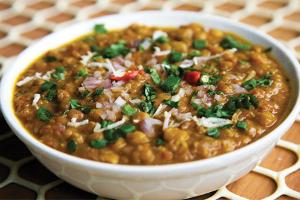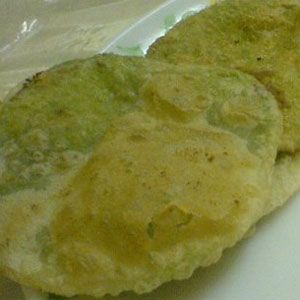Bengali cuisine (West Bengal)
This is a collection of articles archived for the excellence of their content. Readers will be able to edit existing articles and post new articles directly |
Contents |
Bengali cuisine
Bengali recipe: Ghugni koraishutir kochuri
Meghna Mukherjee, TNN | Aug 10, 2013
Here's the recipe to make Ghugni koraishutir kochuri at home
Ghugni
Ingredients: 2 cups of soaked white peas, ½ cup chopped onions, 1 chopped tomato, 1 tsp crushed garlic, 1 tsp ginger, ½ tsp cumin seed powder, ½ cup coriander powder, 1 tsp garam masala, ½ cup oil and salt to taste
Method: Boil the soaked white peas until soft. Heat oil in a separate pan. Fry the onions, ginger and garlic on medium heat. Continue frying till the onion gets brown. Add the tomatoes and stir it properly. Now mix this with the cooked peas. Add the cumin seed powder as well as the coriander powder. Now allow this to come to a boil. Add the garam masala and adorn with coriander and chopped onion. You can also sprinkle some coriander leaves for garnishing.
Koraishutir kochuri
Ingredients: ¼ tsp salt, 3 tbsp ghee
For the filling: ¼ kg peas, 1 inch ginger, 4 small chillies, 4 tsp saunf, ¼ tsp asafoetida, salt to taste and ghee to deep fry
Method: Sift the flour with ¼ tsp salt. Mix in 2 tbsp of ghee and knead to soft dough. Grind the peas, ginger, green chillies and saunf to a fine paste. Fry the asafoetida till light brown. Mix in the peas paste and salt. Fry well till the paste is thoroughly cooked. Take off from heat and let it cool. Divide the dough into eight balls. Press each ball in the centre and fill it with the pea mixture. Close the opening well and flatten them. Roll out the puris. Heat up the ghee in a kadhai. Deep fry the puris on low heat up till golden brown. Remove and serve hot.
Bhaté Bhat
Nov 6, 2022: The Times of India
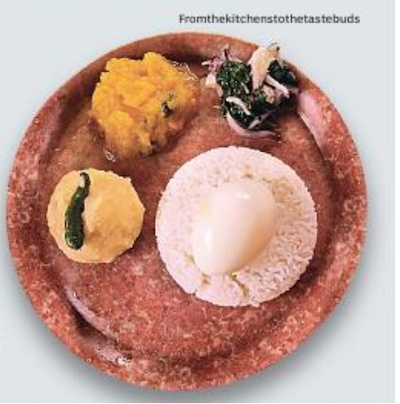
From: Nov 6, 2022: The Times of India
Wash 250 gm of peeled and cubed (1”) sweet potato and place in a closed metal container with 1 cup of water and ½ tsp salt. Place 250 gm of washed and stemmed amaranth leaves in a steamer basket. Bring 3 cups of water to boil in a large (8 quart) pot and place the steamer in it on a trivet and cover. After five minutes remove the leaves and set aside. Add 5 more cups of water, drop in the container with the sweet potato, and bring the whole thing to a boil. Add 1 cup of rice, cook for 13 minutes and then add 6 eggs that were in warm water already. Break the tips of 250 gm of sem, pull out the string and place in another closed metal container with ½ cup of water and ¼ tsp salt. At minute 15, drop the sem container in the boiling water, and at minute 20 remove the eggs and plunge into ice water, drain the rice, open the containers and the vegetables out of the water.
Remove the boiled sweet potatoes. Mash them with ½ tsp deghi mirch, 1 tb finely chopped ginger, 100 gm firm, sweet grapes, quartered, 100 gm walnuts, toasted and broken, 1 tb lemon juice, 1. 5 tb olive oil and salt to taste.
Prepare a relish with 1 cup finely chopped juicy and tasty tomato, 1/3 cup finely chopped onion, 1 thinly sliced green chili, 3 tb finely chopped cilantro and salt to taste. Slice the peeled boiled eggs (careful they may be still pretty soft) and arrange them on a nice plate in concentric circles. Dribble ¼ tsp oil from a lemon or mango pickle on each slice of egg and just before serving, drain the accumulated liquid from the relish and spoon it over theeggs, saving some for extras.
Carefully squeeze the water out of the amaranth leaves with your hands (let them cool a bit first). In a small fry pan, heat 1 tb coconut oil to medium high, and throw in 1 tsp mustard seeds, and when the popping slows, a pinch of hing and some curry leaves, followed by ¼ cup thin sliced shallots or finely chopped onion. When the shallots soften slightly (1 minute) throw in 3 tb fresh ground coconut, lower heat to medium and fry for two minutes, letting the coconut brown. Mix into the amaranth with one thinly sliced green chilli and heat the whole mixture in the microwave before serving.
Mash the sem slightly with your hands or the back of a spoon. Heat 2 tb mustard oil at medium heat in a small fry pan and when hot, throw in ½ tsp kalonji and 1 green chilli. After 40 seconds, add some homemade mustard paste (high quality prepared mustard also works, though it will bring its own unique taste) into the pan, let the oil separate (1 minute), add the sem and salt. Stir to coat the sem and remove.
Get your pickles out (meat and sea-food pickles, too, if you have them), and let the softness wrap around you.
Fromthekitchenstothetastebuds
Some famous cuisines in Kolkata
July 30, 2018: The Times of India
The taste of the City of Joy
Kolkata as the capital city of West Bengal breeds nostalgia, and once you are there, you never feel like leaving the city. Simply the reasons are-the easy city life, the warmth of people and last but not the least-cheap and finger-licking Bengali street food. From easy-to-make Phuchka to the overdose of Chhanar Jilipi, the city offers everything regional that your taste buds would love to relish. According to a survey, reported by The Times of India and conducted by the ‘Taste of Travel’, Kolkata is considered the best destination for a wide range of street food. Here is a list of 11 must-have street foods that truly reflect the diversity of Bengali cuisine.
1. Telebhaja
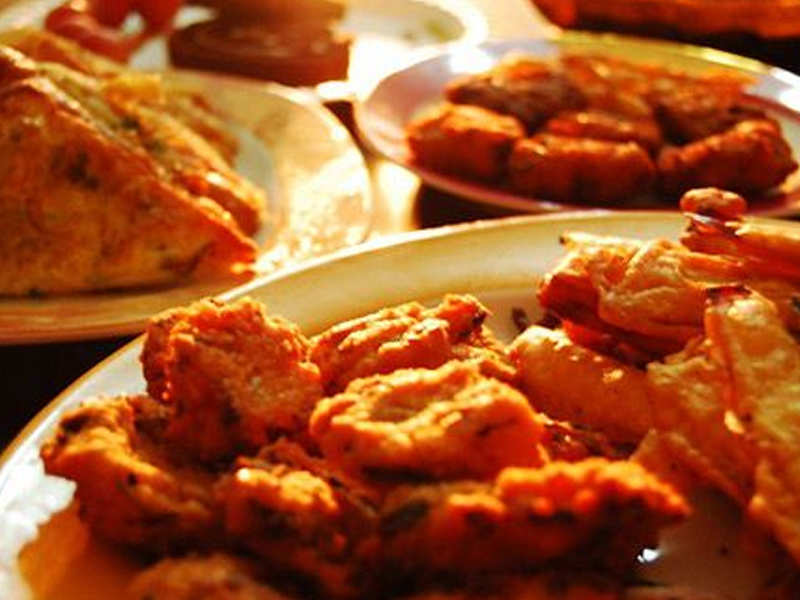
From: July 30, 2018: The Times of India
Here the monsoon evenings are incomplete without the smoking hot delights that are made with besan batter, eggplant, onion, and potato, and are best served with masala tea. FYI, Telebhaja refers to pakodas deep fried in oil. Period!
2. Singara
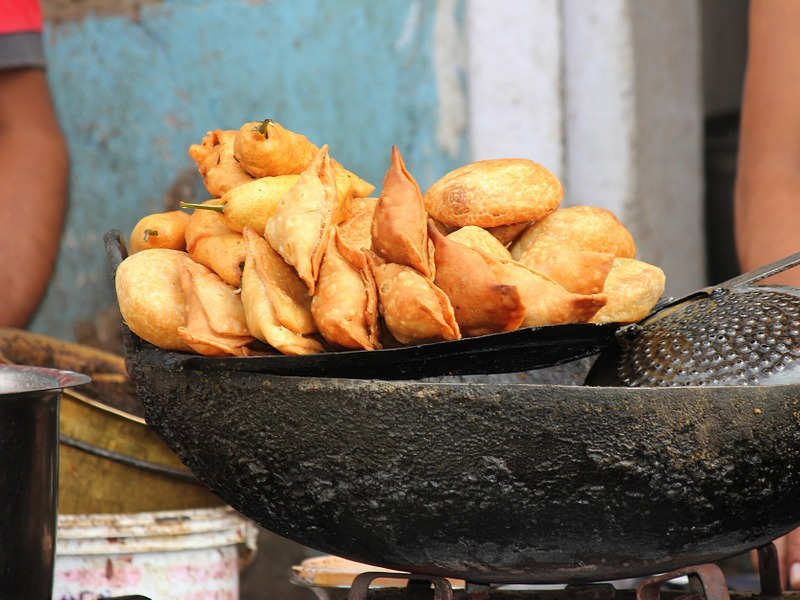
From: July 30, 2018: The Times of India
Well, there is nothing alien about this street snack. What we call as ‘Samosa’ is what Bengalis call as ‘Singara’. The difference lies in the stuffing, size, and shape. Here, the stuffing consists of cauliflower, potato, coconut, roasted peanuts, and mustard oil. Singara is comparatively smaller in size, as compared to samosa.
3. Phuchka

From: July 30, 2018: The Times of India
Golgappas of Delhi and Panipuri of Bombay has a soul sister in Bengal and is called Phuchka. Here, this street dish is so famous that you can easily find more than 25 types of phuchkas in the City of Joy. Sounds tempting?
4. Luchi Aloo
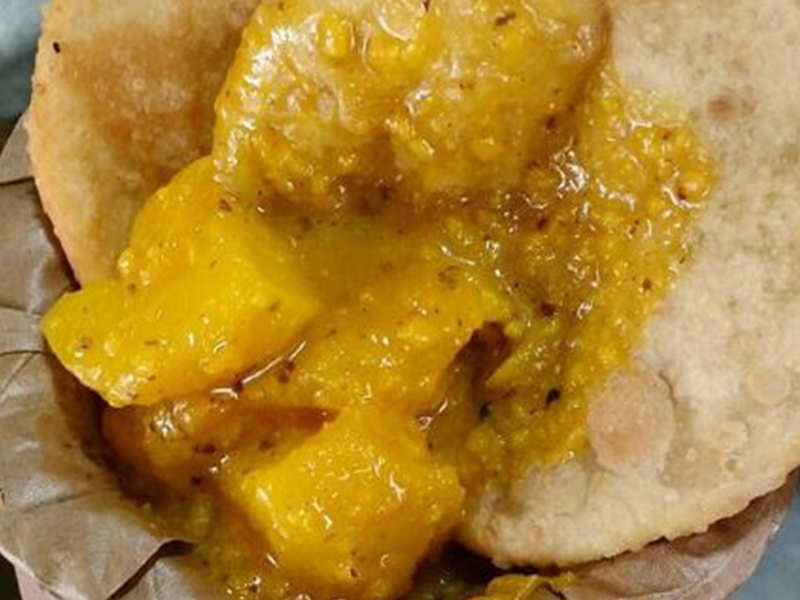
From: July 30, 2018: The Times of India
It’s a famous breakfast dish in the city that is no less than a saviour for the bachelors of the capital and can be relished on streets near every office building along with cutting chai or chach. (Image: instagram/foodgram_india)
5. Keemar Doi Bora
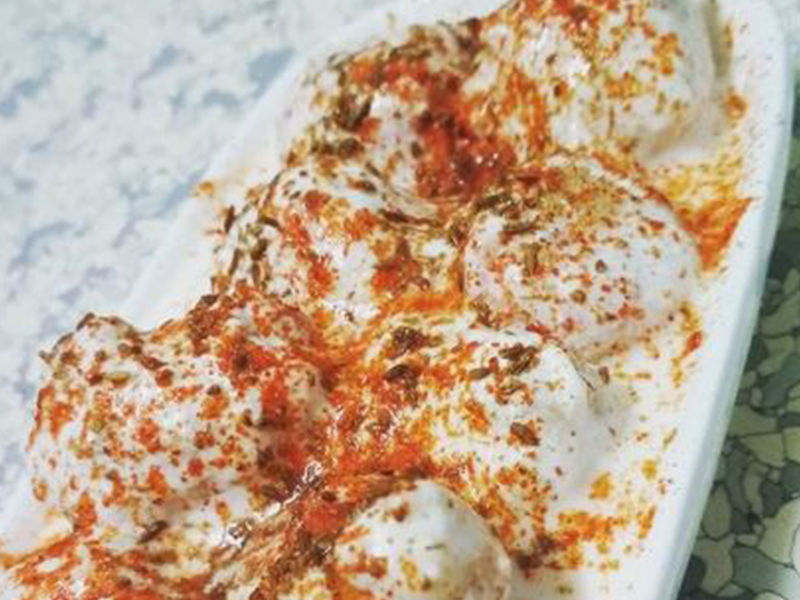
From: July 30, 2018: The Times of India
Keemar Doi Bora is the Bengali version of ‘Dahi Vada’. This sweet and savoury dish involves deep-fried balls of minced meat soaked in a pool of sweetened and spiced yoghurt. You can easily spot the stalls of Doi Bora across the city.
6. Kathi Rolls

From: July 30, 2018: The Times of India
Visit the city and try the Kathi rolls available on the street stalls and you will forget the flavour of established brands selling rolls.
7. Jhal Muri

From: July 30, 2018: The Times of India
Prepared with puffed rice, onion, green chilli, mustard oil, salt, pepper and mustard paste, this street snack is served in a paper cone and is a must-try near the banks of the Hooghly River, and outside Victoria Memorial.
8. Ghugni

From: July 30, 2018: The Times of India
Easily available in every nook and corner of the city, Ghugni is a boiled and pan-fried dish made with white and yellow gram peas. The peas are tossed in a pan along with chopped onion, green chilli, lemon juice, spices and fresh coriander leaves.
9. Fish cutlet and chop

From: July 30, 2018: The Times of India
Your street food journey in Kolkata is incomplete without crispy fish cutlet and chop that are usually served with ketchup, chilli sauce, and pudina chutney. Tempting?
10. Churmur

From: July 30, 2018: The Times of India
It is a crushed and dry version of panipuri/phuchka. Easily available on all phuchka stalls, this savoury dish is all about crushed panipuri balls, boiled peas, salt, pepper, tamarind chutney, lemon juice and chilli powder.
Chicken kabiraji
Meghna Mukherjee, TNN Jul 24, 2013
(Make chicken kabiraji at…)
We share with you the recipe to make 'chicken kabiraji', a popular Bengali snack, at home.
Ingredients:
Cumin Powder - 2 tsp
Chicken - 250gms
Garlic grated - ½ tbsp
Ginger grated - 1 tbsp
Green chillies - 2
Onions - ½ kg
Eggs - 5
Salt to taste
Red chilli powder - ½ tsp
Lemon juice - 2 tsp
Oil - for frying
Breadcrumbs - 2 tbsp
Method:
- Grind onions ginger, garlic and green chillies
- Cut chicken pieces in a bowl; add the mixture (from step 1)
- Add cumin powder, red chilli powder, lemon juice
- Marinate chicken pieces and leave the mixture for about 45 minutes
- Whisk eggs in a bowl
- Dip cutlets in the whisked egg and roll on breadcrumbs
- Heat oil in a pan
- Add marinated chicken pieces
- Keep frying till they become golden brown in colour
- Serve hot with your choice of sauce/chutney
Sandesh
IPSHITA MITRA Jul 17, 2013, 12.00AM IST
(Soft, melt-in-mouth Sandesh…)
The first question a Bengali from Kolkata is asked after he unpacks his luggage and prepares to settle down is, "Kaku sandesh enechho toh?" (Uncle, have you got sandesh?).
For Bengalis, any celebration is incomplete without the customary 'sandesh' (a sweetmeat snack made from milk cream and sugar) to round it up with. So much so that people in Dhaka, Bangladesh, like to call the sweet 'pranhara' which is the Bengali of 'heart stealer'.
So whether your child has secured the highest marks in class, your daughter's wedding is on cards or you have received a promotion letter at work, you simply cannot break the news to your loved ones without being ready with that box of 'sandesh'!
Sandesh, if you closely see has a clear meaning attached; it means 'news' in Hindi. Being an inherent part of Bengali culture and festivity, sandesh became a 'messenger' of auspicious news creating an atmosphere of mirth and jubilation in Bengali households.
Sandesh's Portuguese connect
There is an interesting anecdote attached to the origin of this sweet delicacy. In mid-late 17th century, there was an influx of Portuguese traders into the 'City of Joy,' where they settled around the geographical region of Hoogly. With professional bakers and Portuguese confectioners making inroads, Bengal too geared up to skilful preparation of sweetmeats, cakes, breads and other delicacies.
The Portuguese cheese that was the staple ingredient in the making of the sweet soon became Bengali 'chhana', better known as cottage cheese extracted by curdling milk. It was not a blind emulation after all. The industry picked up and became a rage as variations in the sweet were introduced. From Kachagolla, rasogolla, cham-cham to rasmalai, 'sandesh' graduated toindigenous forms and ethnic tastes.
So wouldn't it be a great idea to try some quick and easy-to-make sandesh recipes this season? Here is a compilation of three such sandesh recipes:
Pista Sandesh
Ingredients:
Chhana (made from 1/2 gallon of milk)
Powdered Sugar (3/4 cup, or to taste)
Small Cardamom Powder (1 tsp)
Pistachios (25 unsalted, 18 whole and rest sliced)
Small muffin cups (15-18, optional)
Method:
-Make fresh Chhana from 1/2 gallon of milk and press it with something heavy for 45 minutes, so that all the water comes out.
-In a large bowl, start mashing it with your hands until smooth and a ball is formed. The heat from your hand will help it in becoming soft and smooth, which is very important since we are not cooking anything.
-Now add powdered sugar and cardamom powder. Mix well with hands.
-Divide the prepared Chhana into 15-18 equal portions.
-Roll one of them between the palms of your hands and flatten it.
-Put one pistachio in the middle and roll into a ball.
-Put each one of them in the muffin cups and garnish with sliced pistachios.
-Let them set for 3-4 our in the freeze, before serving.
(Chef Arunava Mukherjee, Senior Sous Chef at Courtyard by Marriott, Mumbai International Airport)
Zafrani Sandesh
Ingredients:
1/2 gallon (8cups) milk
1/4 cup lemon juice
1/2 cup sugar
1/4 teaspoon ground cardamom
1 teaspoon saffron dissolved in 2 tablespoons warm milk
Method:
- In a big heavy bottom pot on high heat, bring the milk to a boil and reduce the heat. Reduce the heat to low and add the lemon juice, stirring occasionally.
- Let it rest for 2 to 3 minutes, until the milk solids have been separated. Strain the water out and reserve the solids. This will be your 'chhana'.
- Add the sugar to the chhana and mix gently.
- Add the cardamom and saffron and cook the mixture on a very low flame in a heavy bottom skillet, stirring continuously with a flat wooden spoon.
- Remove the skillet from heat at regular intervals so as not to overheat the mixture. This avoids the mixture to become grainy, and fat will separate.
- The sandesh is ready when it leaves the sides of the skillet and is neither too dry not too moist. It should have the consistency of a very soft dough.
- The sandesh should be cast into mould soon after.
(Contributed by Chef Vikas Khanna, judge, Masterchef season2, StarPlus, India)
Malai Cham Cham (another sandesh variety)
Ingredients:
2 liters full cream/ whole milk
2-3 tbsps lime/lemon juice
5 tsps flour
4 cups water
2 cups sugar
2-3 tbsps rose water or a few strands of saffron
A few drops of yellow food colour (according to your preference)
200 gms fresh thickened/ heavy/ double cream
Method:
- Bring the milk to a boil over a medium flame. Stir occasionally to ensure the milk does not burn. When the milk begins to boil, add the lime juice and mix well. When the curds begin to separate from the milk, turn off the fire and leave the milk aside for 10 minutes to let the curdling process finish.
- Strain the cheese and wash it well under running water - to remove all the lime juice from it. Now put the cheese in cheesecloth and hang for 1 hour to completely drain all the liquid from it.
Bengali recipe: Kosha Mangsho
Arunima Mazumdar, TNN Sep 11, 2013, 12.00AM IST
Tags:
Turmeric|
Subtle|
spicy|
mutton curry|
Mutton|
mustard oil|
Kosha Mangho|
Garam Masala|
flavours|
Bengali
(Bengali recipe: Kosha Mangsho…)
One of the biggest joys in life is to sit with your family and enjoy a delicious lunch on a lazy Sunday afternoon. And the joy is bigger when the lunch is a preparation of traditional, authentic Bengali cuisine.
Among the myriad renowned Bengali dishes is one dish that never fails to impress anyone. It's the Spicy Bengali Mutton Curry aka Kosha Mangsho! It's a known fact that most Bengalis live to eat and not the other way round, and most of them have grown up licking their fingers to Kosha Mangsho's velvety gravy and biting into the juicy pieces of the meat, cooked lovingly by their grandmothers and mothers. Today, we bring you the recipe of this sumptuous dish straight from a Bengali kitchen.
Ingredients
750 grams mutton
3 medium sized potatoes cut into equal halves (Optional)
1-2 tbsp of mustard oil to fry the potatoes
3-4 medium sized onions
1 tsp garam masala
1 ½ tsp meat masala
To marinate the mutton
7-8 cloves of garlic
1 ½ inch thick ginger
2 tsp turmeric powder
1 ½ tsp red pepper powder
1 ½ tsp coriander powder
1 ½ tsp salt
4 heaped tbsp of yogurt
To temper
10 - 12 black peppers (uncrushed)
3 bay leaves
4 whole cardamoms
5 cloves
½ inch long cinnamon stick
1 tsp of sugar
½ cup mustard oil
Method
Marinating the mutton
1. Bring together garlic, ginger and onions. Grind them together in a mixer to make a smooth paste.
2. Wash and clean the mutton. Add to it the ingredients for the marinade - yogurt, turmeric powder, coriander powder, red pepper powder, some mustard oil, and half of the ginger/garlic/onion paste. Let it rest for about 2 hours. If you have time on your hands, let it rest overnight. Ensure that you prick the mutton with a fork so that it absorbs all the flavours.
3. Heat 2 tbsp mustard oil in a wok. Fry the potatoes till they turn golden brown. Keep them aside.
Cooking the mutton
1. Heat the remaining mustard oil in another wok. Add some turmeric to it. Then, temper it with the black pepper, cinnamon stick, bay leaves, cloves, and cardamom. Also add sugar to it. The sugar gives a nice red colour to the gravy and also contributes to the subtle sweetness of the spicy gravy.
2. Add the remaining onion paste along with meat masala and fry for about 5 minutes. You'll notice the oil separating from the mixture.
3. Now add the marinated mutton. Cook at a low flame for about half and hour.
4. Add 2 cups water (depending on how much gravy you want) and cover the wok. Let the mutton cook for at least an hour now till the mutton becomes soft and succulent. All this while, ensure that the flame is at its lowest.
5. Now, add the fried potatoes and garam masala, and give it good stir. Let it cool for sometime and then sprinkle freshly chopped coriander leaves.
Serve hot with either steamed rice, maida luchi (pooris) or parathas. Follow it up with Bengali desserts like mishti doi or soft roshogullas!
Cholar dal
Dec 3, 2023: The Times of India
Pressure cook cup chana dal till soft. In 2 tbs ghee, cook 4 tbs fresh coconut cut into thin slices till they start to turn red. Remove from the ghee. In the same ghee, fry 1” piece of cinnamon, 4 cloves, 4 cardamom pods and 1 bay leaf for a minute and then 2 tsp each of ground garlic and ginger. Fry for another minute and add 1 tsp each of turmeric, cumin powder, coriander powder, cayenne and salt. After a minute add cup finely chopped tomato and fry at medium heat till it’s almost a paste (3 minutes or so). Add the dal with its cooking liquid plus 1.5 cups of water and cook at low-medium for 10 minutes. Add the fried coconut, ¼ cup kishmish and 1 heaped teaspoon sugar. Simmer for 5 minutes. It should be sweet, savoury and a little bit hot. Adjust the balance of sweet and salty to your taste.
Palong saager ghonto
Dec 3, 2023: The Times of India
Marinate 200 gm of tiny shrimps with salt and turmeric (or if you lean vegetarian, 15 small vadis). Fry them in 1.5 tbs mustard for 2 minutes at medium heat. Turn off heat and fish them out. Heat the remaining oil at medium high, throw 1 tsp panchphoron (a five-spice mix) and 1 green chili. After 1 minute, add 1 cup each of pumpkin and eggplant plus ½ cup muli (daikon) all in 2cm cubes, plus 1 tsp salt and turmeric and ½ tsp cayenne. Cover, set heat to medium low and cook until the vegetables are melting (20-25 minutes). Add 3 packed cups of washed spinach leaves, and let them wilt and blend in. Add 2 tsp freshly grated ginger and the shrimps, cook two minutes and remove. If you used vadis, break them into small pieces and garnish the dish.
3 must-learn Bengali treats
[http://articles.timesofindia.indiatimes.com/2013-06-05/recipes/30289464_1_chillies-potatoes-seeds
Meghna Mukherjee, Jun 5, 2013, 12.00AM IST
Tags:
Subtle|
Smoking|
potatoes|
fish|
Bengali cuisine|
Aloo posto
(The bengali feast (Image…)
Bengali cuisine is known for its subtle flavours and sweets, with an emphasis laid on lentils and fish. Indian Master Chef, Renaissance Hotel, Mumbai, Chef Ajay Mishra, shares some recipes to try out this season.
Chanar Dalna
Ingredients
- 1 tblsp Ghee
- 250 gms Cubed cottage cheese (paneer)
- 1 Medium cubed potatoes
- Oil for frying
- 1/4 tsp Turmeric powder
- 1 tsp Ginger paste
- 2 - 3 Green chillies
- Salt to taste
- 1 1/2 tsp Cumin seed paste
- 1/2 Cup milk
- 1/2 tsp Cumin seeds
- 1/2 tsp Sugar
- 1/2 tsp Garam masala powder
- 1 cup Water
Method
- Heat up oil, fry the potatoes lightly and keep aside.
- Fry the paneer in the same oil and put them in warm water.
- Heat up the ghee in a vessel, mix in the cumin seeds and let them splutter.
- Mix in the cumin paste with a little water, ginger juice and turmeric powder.
- Stir fry for 2 minutes.
- Mix in the potatoes, green chillies, garam masala powder, sugar, salt and cover and stir fry till the potatoes turn tender.
- Heat up oil and fry the potatoes lightly and keep aside.
- Take off the paneer from the water and mix in to the potatoes.
- Mix in milk and the remaining water and allow it to simmer for another 2 to 3 minutes.
- Serve hot with steamed rice.
Aloo posto
Ingredients
- 5 - 6 Medium potatoes
- 2 Green chillies
- 1/2 tsp Sugar
- 1 tsp Pure ghee
- 2 tblsp Mustard oil
- 4 tblsp Poppy seeds (khuskhus)
- Salt to taste
- 1/2 tsp Onion seeds (kalonji)
Method
- Peel off the potatoes and cut them into one inch sized pieces.
- Keep them in water.
- Soak poppy seeds in one cup warm water for 15-20 minutes.
- Remove and grind them to a fine paste.
- Heat up mustard oil in a pot till it reaches smoking point.
- Remove, cool and heat up the oil again on medium heat.
- Mix in Kalonji and stir-fry.
- Mix in the potatoes and stir fry on medium heat up for 5 minutes, stirring frequently.
- Mix in the poppy seed paste, stir and mix in half cup of water.
- Cover and stir fry on low heat up till the potatoes are almost done.
- Take off the lid, mix in salt, sugar, and slit the green chillies.
- Continue to stir fry for a minute more or till the potatoes are completely cooked, stir in desi ghee and serve hot.
- Serve hot with steemed rice and garnish with green chillies.
Macher jhol
Ingredients
- 1/4 tsp Onion seeds (kalonji)
- 2 Medium potatoes
- 5 Green chillies
- 1 1/2 tblsp Coriander seeds
- 1 Small sized fish (preferably rohu)
- 3 tblsp Mustard oil
- 2 tsp Turmeric powder
- Salt to taste
- 1 tsp Cumin seeds
Method
- Clean, cut and take out the head of the fish.
- Clean inside of the fish and wash thoroughly.
- Cut the fish into half-inch thick slices.
- Pat dry with a kitchen towel and apply salt and turmeric powder.
- Wash, take off and cut potatoes into half-inch thick finger sized pieces.
- Wash, take off stems and slit the green chillies.
- Dry roast coriander and cumin seeds briefly, cool and grind to a fine paste, adding a little water.
- Heat up two-tblsp mustard oil in a pot till it just reaches smoking point.
- Remove, cool and heat up the oil again on medium heat.
- Mix in the fish slices, few at a time and fry for a minute on each side.
- Remove and keep aside.
- Mix in potato pieces to the pot and stir fry for two to three minutes.
- Heat up remaining oil in the same pan, mix in kalonji, slit green chillies and stir-fry briefly.
- Mix in coriander-cumin paste and stir fry on low heat up for a minute sprinkling a little water, if required.
- Mix in two-cup of water, sauteed potatoes, salt and simmer (boil slowly at low temperature) for four to five minutes or until the potatoes are completely cooked.
- Gently slide in the pot fried fish slices and simmer (boil slowly at low temperature) for two to three minutes or until the fish is cooked.
- Serve hot with steamed rice.
